News
M. Cruthirds, News Editor
Air Products inks Yamal LNG agreement
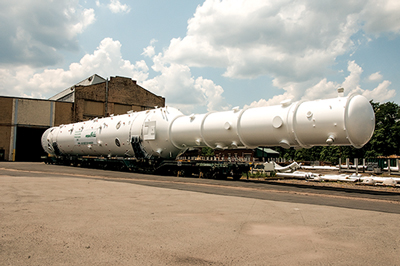
Air Products has signed an agreement with a consortium, including Technip and JGC Corp., to implement the Yamal LNG project. The LNG plant, under construction on the Yamal Peninsula, will mark the first time Air Products will deploy its proprietary LNG technology and equipment in Russia. The plant will be Russia’s largest LNG production and export facility.
The company will supply three of its proprietary MCR cryogenic heat exchangers, to be installed at the heart of the propane precooled mixed-refrigerant liquefaction process. Each of these units, using Air Products’ AP-C3MR LNG process technology and equipment, will produce 5.5 Mtpy of LNG, for an overall total of 16.5 Mtpy at three trains.
The project is the largest of its kind in the Arctic, and it is the northernmost LNG facility in the world. With the addition of Russia, Air Products’ LNG technology will be operating in 17 countries around the world. LNG from the Yamal project will be used primarily to meet growing energy demand from the Asia-Pacific region. Image courtesy of Air Products and Chemicals Inc.
New gas treating technology in development
Honeywell’s UOP has signed a joint development agreement with Qatar Petroleum (QP) to develop new ways to cost-effectively treat natural gas for LNG production. Under the agreement, the two companies will work together to develop more efficient technologies to remove contaminants from natural gas, so that it can be liquefied for transport by ship and other means.
UOP’s separation technology and equipment remove contaminants such as sulfur, water and carbon dioxide from natural gas, to meet rigorous product specifications and requirements for downstream transmission and liquefaction equipment. QP’s JV companies, Qatargas and RasGas, have a combined LNG production capacity of 77 MMtpy, making Qatar the world’s largest producer and exporter of LNG.
MarkWest expands US processing sites
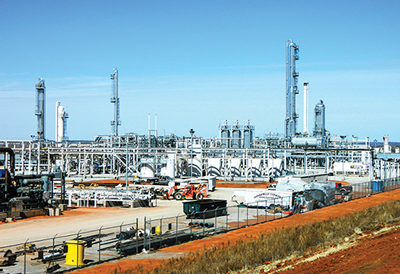
MarkWest Energy Partners has completed work on its 200-MMcfd Buffalo Creek cryogenic gas processing plant and an associated high-pressure trunk line in the Granite Wash shale. The Buffalo Creek facility, located in Hemphill County, Texas, is supported by long-term, fee-based agreements with Chesapeake Energy. As part of the gas processing agreement with MarkWest, Chesapeake dedicated approximately 130,000 acres throughout the Anadarko basin.
The completion of the Buffalo Creek plant increases the partnership’s total processing capacity in the Anadarko basin to 435 MMcfd at two major complexes. The Buffalo Creek facility and the 235-MMcfd Arapahoe processing complex in western Oklahoma are connected through MarkWest’s rich gas gathering system, which provides 575 MMcfd of gathering throughput capacity.
The partnership’s infrastructure includes multiple residue gas outlets and access to natural gas liquids takeaway pipelines to Mont Belvieu and Conway.
Malaysian FLNG project makes FID
Petronas has reached a final investment decision (FID) for its second FLNG project, PFLNG 2, off the coast of Sabah, Malaysia. Subsequently, the company issued a letter of award for the project’s engineering, procurement, construction, installation and commissioning (EPCIC) contract to a consortium of JGC Corp. and Samsung Heavy Industries Co.
The EPCIC contract award followed the 2012 dual-FEED study for the project, which was undertaken by two consortia—the Modec Inc., CB&I Nederland and Toyo Engineering Corp. consortium, and the JGC Corp. and Samsung Heavy Industries Co. consortium.
The FID and the EPCIC contract awards mark significant milestones in the progress of the PFLNG 2 project. The facility will be moored at the Rotan gas field, in deepwater Block H offshore Sabah, and is designed to produce 1.5 MMtpy of LNG. It is scheduled to be ready for startup by early 2018.
Meanwhile, Petronas’ first FLNG facility (PFLNG 1) project recently achieved another key construction milestone, with the commencement of the vessel’s keel-laying process at the Daewoo Shipbuilding & Marine Engineering shipyard in Okpo, South Korea. The PFLNG 1 barge will be moored at the Kanowit field, offshore Sarawak, and is designed to produce 1.2 MMtpy of LNG. The project is slated for startup by the end of 2015.
Australian EPA backs Gorgon expansion
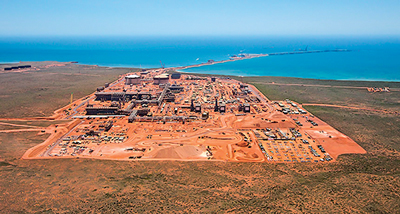
Chevron Australia’s proposal to increase the footprint of its Gorgon gas development has been recommended for conditional approval by Western Australia’s Environmental Protection Authority (EPA). The proposal would see the undertaking of clearing and earthworks for 32 more hectares on Barrow Island, with additional construction laydown and operations support to the existing Gorgon gas development.
EPA Chairman Paul Vogel said the proposal was assessed to determine if the existing conditions on the development could be applied to the revised footprint. The authority “concluded that the conditions set out in the original approval are effective in managing impacts and should be implemented for the additional development.”
However, the EPA also recommended a condition to offset the significant residual impacts of clearing 32 hectares of the Class A nature reserve, including habitat for protected fauna. The EPA asked that the impact to the area be offset by extending the established Threatened Species Translocation and Reintroduction Program from 12 years to 14 years. Mr. Vogel said that Chevron Australia had also committed to rehabilitate land within the development envelope, even after it is no longer required to support construction and operation of the Gorgon gas development. Photo courtesy of Chevron Australia.
Wison to supply FLNG regasification unit
Wison Offshore & Marine Ltd. has signed a binding agreement with owner Vessel Gasification Solutions (VGS) for the supply of the industry’s first barge-based FLNG regasification unit (FLNGRU), to be installed offshore India. The FLNGRU will consist of a newbuild, non-propelled barge equipped to perform the regasification and sendout of a maximum of 1,000 MMscfd of gas.
The facility will be moored on a jetty structure approximately 8 km offshore Andhra Pradesh, on India’s east coast, to the northeast of the Kakinada Anchorage Port, alongside a permanent floating storage unit to be used as the LNG offloading point for trading tankers. Furthermore, the FLNGRU will be sized to allow for the future expansion of regasification capacity by an additional 750 MMscfd within the next few years.
Under the agreement, Wison affiliates will be responsible for the turnkey engineering, procurement, construction, installation and commissioning of the unit, and will lead the project from its Shanghai operations center, with construction to be performed at the company’s fabrication facility in Nantong, China.
Cameron LNG gets non-FTA greenlight
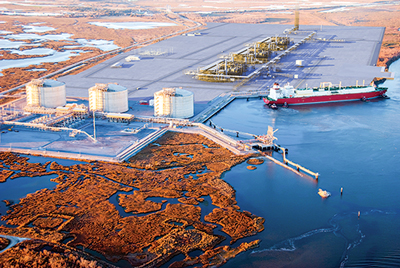
The US Department of Energy has approved LNG exports from Sempra Energy’s Cameron LNG project, officials announced in February. The conditional approval of exports from the Louisiana terminal to countries with which the US does not have a free trade agreement (FTA) is the sixth approval from the US since 2011.
Cameron’s application to export up to 1.7 Bcfd raises the total of approved, potential LNG export volumes from the US to approximately 8.5 Bcfd.
Cape’s contract extended for PNG LNG
Cape Plc, a provider of support services to the energy and natural resources sectors, has announced the extension of a contract between Cape PNG Ltd. and a joint venture (JV) of Chiyoda Corp. and JGC Corp. The contract is worth $2 MM and is associated with the provision of supervision, pipefitting, rigging, crane operations, administration, general tools and equipment rental for the PNG LNG project.
The PNG LNG project is an integrated development that includes gas production and processing facilities, onshore and offshore pipelines, and liquefaction facilities. Participating interests include Esso Highlands Ltd. as operator (33.2%), Oil Search Ltd. (29%), National Petroleum Co. of Papua New Guinea (PNG government, 16.6%), Santos Ltd. (13.5%), JX Nippon Oil and Gas Exploration Corp. (4.7%), Mineral Resources Development Co. (PNG landowners, 2.8%) and Petromin PNG Holdings Ltd. (0.2%).
SK wins EPC work for Magnolia LNG
Australia-based Liquefied Natural Gas Ltd. has enlisted South Korea’s SK Engineering and Construction as the engineering, procurement and construction (EPC) contractor
for its planned, 8-MMtpy Magnolia LNG export project in Lake Charles, Louisiana. Construction of the project is slated to begin in 2015, with operations starting in mid-2018.
Under the agreement, the two companies will work together to reach a bankable fixed-price EPC contract for the project. SK has already reviewed Magnolia LNG’s Optimized Single Mixed Refrigerant (OSMR) process technology, which will be used on the project.
Subject to final verification, the project will include four LNG production trains, each with a minimum design capacity of 2 MMtpy, and a capacity guaranteed by SK of at least 1.7 MMtpy.
SK also gave an initial capital cost estimate of $1.57 B for the first phase of EPC work. The first phase will include two LNG trains, gas treatment facilities, two
160-Mcm storage tanks, a jetty and ship-loading facilities, and related infrastructure.
Phillips 66 approves NGL, LPG projects
Phillips 66 has received approval from its board of directors to move forward with both its Sweeny Fractionator One project and its Freeport LPG export terminal. These two projects, both located along the upper Texas Gulf Coast, represent an investment of more than $3 B.
The Sweeny Fractionator One project will be located in Old Ocean, Texas, close to the company’s Sweeny refinery, and will supply purity NGL products to the petrochemical industry and heating markets. Y-grade (mixed NGL) supply to the fractionator will come from nearby major pipelines, including the recently completed Sand Hills Pipeline, in which Phillips 66 owns a 33% interest. The 100-Mbpd NGL fractionator is expected to start up in the third quarter of 2015.
Meanwhile, the Freeport LPG export terminal will be located at the site of the company’s existing marine terminal in Freeport, Texas. The terminal will have an initial export capacity of 4.4 MMbbl/month, the equivalent of eight very large gas carriers (VLGCs), with a ship loading rate of 36 Mbbl/hr. Startup of the export terminal is expected in mid-2016.
Each of these projects will include NGL storage and additional pipelines with connectivity to market hubs in Mont Belvieu, Texas. Also included with these projects is a 100-Mbpd deethanizer unit, to be installed close to the Sweeny refinery to upgrade domestic propane for export.
The Sweeny Fractionator One project site preparation is progressing, critical equipment has been ordered, and expansion of supporting infrastructure has begun. For the Freeport LPG terminal, the company is working with the appropriate agencies to secure necessary permits.
BP picks KBR for Shah Deniz engineering
BP has awarded KBR a contract to provide detailed engineering and procurement support services for the Shah Deniz Stage 2 project, in the Azerbaijan sector of the Caspian Sea. The contract win follows KBR’s successful completion of FEED services for Shah Deniz Stage 2, and will be delivered through the company’s offices in the UK, Singapore and Indonesia.
KBR will provide engineering design and procurement support services for an onshore gas processing facility, as well as an offshore complex consisting of two bridge-linked, fixed-jacket platforms. The onshore facility consists of two gas processing trains, each with a capacity of 900 MMscfd, and condensate processing facilities with an approximate capacity of 105,000 bpd located adjacent to the existing Shah Deniz Stage 1 facilities at Sangachal Terminal. The work began in January and will run through 2018.
Praxair upgrades air separation plants
Praxair has completed an upgrade to its air separation liquefaction capabilities in Fort Saskatchewan and Prentiss, Alberta. In addition, the company has completed the construction of new carbon dioxide and liquid nitrogen distribution and storage facilities in Grande Prairie, Alberta, and Dawson Creek, British Columbia.
Praxair Canada also operates more than 50 km of pipelines in the Edmonton-Fort Saskatchewan corridor.
PVR Midstream selects gas measurement system
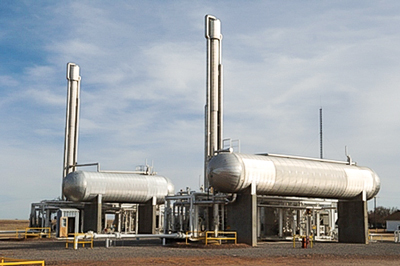
Flow-Cal Inc. will provide an advanced gas measurement software solution for PVR Partners’ midstream assets. PVR’s midstream business operates in the Marcellus shale in Pennsylvania and West Virginia, as well as in the Mid-Continent segment in Texas and Oklahoma.
PVR purchased the FLOWCAL Enterprise Gas Measurement software with the field calibration module, TESTit, completely integrated. The TESTit software optimizes measurement operations while enhancing data integrity, and provides measurement departments with automated means of integrating the needs of both office and field personnel.
Flow-Cal’s Enterprise system links larger, more complex operations to a central system, providing a common user interface to consolidate, review, validate, edit, store and report measurement data. The data validation and editing features automated field data processing, producing fast, accurate and auditable results. Photo courtesy of Flow-Cal Inc.




Comments